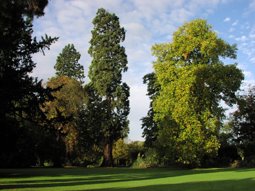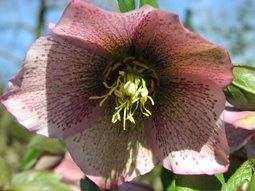Walls and fences can sometimes be overlooked in the garden, and are incredibly useful for supporting climbers and trained shrubs. These add an extra dimension to your garden – a horizontal one! As plants with winter interest need selecting carefully, I have listed a selection of plants which provide either flowers, berries, or evergreen leaves during November to January.
An evergreen Clematis which flowers in the winter is Clematis cirrhosa. There are a few varieties to choose from, the flowers are pale cream, sometimes spotted red, and hang delicately like small bells. Another evergreen is Clematis armandii, with large leathery leaves but this doesn’t flower until spring.

Cheerful yellow flowers can be found on bare branches during late winter covering a couple of wall trained shrubs. Forsythia suspensa has bright yellow blooms, while the delicate looking pale yellow flowers of Chimonanthus praecox are strongly scented. Popular Jasminium nudiflorum, the Winter Jasmine is a tough shrub and easy to grow.
Berries will provide winter colour along with food for the birds, and evergreen Pyracantha’s can easily be trained along fences and walls. They will flower and fruit well even in positions which receive little sun, and varieties are available with orange, yellow or red berries. Cotoneaster horizontalis can also be used to similar effect with bright red berries.

Evergreen Ivys (Hedera) can be used as a backdrop with summer flowering climbers twining through them, as can Garrya elliptica, the Silk Tassel Bush with its dangling catkins throughout winter. Normally seen as a shrub, Lonicera x purpusii ‘Winter Beauty’ can be wall trained, and is worth seeking out for its sweetly scented white flowers.
 Daffodils brightly herald the start of spring, but the subtle charm of the Snakes head Fritillary is hard to outdo. Each slender stem of this spring bulb carries a hanging bell-shaped bloom, heavily chequered with dark purple and white squares, an effect rarely seen on petals.
Daffodils brightly herald the start of spring, but the subtle charm of the Snakes head Fritillary is hard to outdo. Each slender stem of this spring bulb carries a hanging bell-shaped bloom, heavily chequered with dark purple and white squares, an effect rarely seen on petals.























